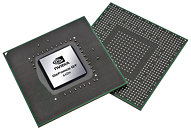Tuesday, April 17th 2012

NVIDIA Approaching Other Foundries than TSMC for 28 nm Production
NVIDIA, along with Qualcomm, is reportedly in talks with foundries other than TSMC, for manufacturing of its new 28 nm chips. Despite the fact that TSMC is ramping up its 28 nm capacity at a breakneck pace, NVIDIA is seeing a shortage of production that could affect its competitiveness. An interesting revelation here is that NVIDIA has begun sampling its GPUs on Samsung's 28 nanometer fab process. Samsung uses this process for contract-manufacturing of ARM application processors. Other foundries with proven 28 nm manufacturing capability include UMC.
Source:
DigiTimes

21 Comments on NVIDIA Approaching Other Foundries than TSMC for 28 nm Production
Besides, NVIDIA will not risk giving its designs to Intel (a GPU competitor, which could steal its designs for processor graphics).
EDIT: Just read the end of the article, was unaware Samsung had a 28nm line.
i mean its not like tsmc have been faultless in the past as most of nv issues the past 5 years have been caused at the fab.
If Nvidia is decided to change to another foundry, it means it's ready to loose a few months testing the new process and if that is the case, I'm sure they wouldn't mind spending a few extra weeks if that means making their GPUs on a much smaller and reliable process, such as Intel's 22nm.I don't think that's a real problem right now. First of all making the hardware is not the most difficult task for a company doing processors for 40 years, it's the drivers what really makes the difference between a CPU an a GPU. HD3000 and specially HD4000 are already a very decent piece of hardware for their size.
Second and most important, Nvidia already shared their patents when they settled the lawsuit with Intel, so I don't think there's much more secrets to be found in the "silicon". IMHO any secrets/tricks that might be found on silicon (power reduction, lower latency, higher clock...) probably Intel knows better*.
And in fact, Nvidia CEO already called Intel to start making ARM chips on contract. Newer Tegras will have Kepler GPU inside so they surely aren't very concerned about Intel stealing anything if they want Intel to make future Tegras for them.
* BTW who's to say that a lot of the improvements in Kepler didn't come from the patents Intel shared as part of the deal? Even GPU Boost is similar to Turbo Boost, in the name too, where you might risk a lawsuit.
Seems to me that AMD's success is related to the number of wafers they purchased, and nvidia cannot get enough wafers, so is looking elsewhere. It doesn't realyl indicate rel problems at TSMC, other than that they cannot meet consumer(OEMs are their consumers) demand.
If nVidia is sampling Samsung process already, they are running wafers out to verify yields.